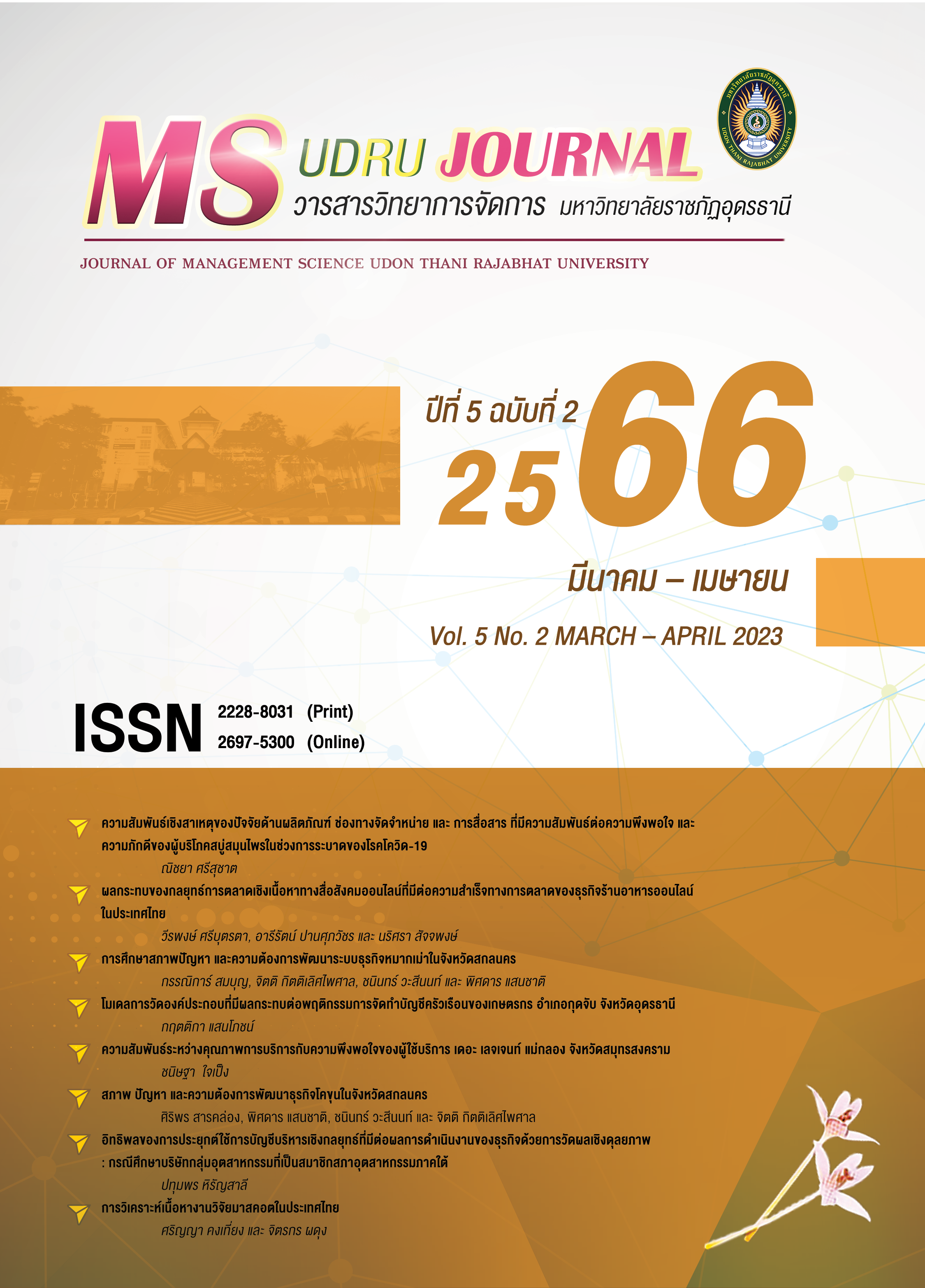A COMPONENT MEASUREMENT MODEL AFFECTING HOUSEHOLD ACCOUNTING BEHAVIOR OF FARMERS. KUT CHAP DISTRICT, UDON THANI PROVINCE
Main Article Content
Abstract
The purpose of this study was to examine a component measurement model affecting household accounting behavior of farmers in Kut Chap District, Udon Thani Province, with empirical data, The sample were farmers who lived in Kut Chap District, Udon Thani Province, 240 cases by stratified random sampling method. Data were collected from a questionnaire and analyzed by confirmatory component analysis. The results showed that the model was consistent with the empirical data. The factors affecting household accounting behavior of farmers consisted of 4 components and 14 indicators, namely, attitude component, 4 indicators consisting of better living; spending prudently, and not extravagantly, the need for a household accounting. and proper financial planning; There are 4 indicators of family members' cooperation components; cooperation in preparing household accounts, giving importance to the preparation of household accounts, time division for taking notes and consistent compliance with household accounting principles. Components of skills, knowledge, and understanding. consisting of 3 indicators; knowledge on household accounting, understanding of household accounting principles and skills and expertise in preparing household accounts. There are 3 indicators of benefit perception components; family financial planning, recognition of family income and expenses, and increasing the family's net income and savings.
Article Details

This work is licensed under a Creative Commons Attribution-NonCommercial-NoDerivatives 4.0 International License.
บทความที่ได้รับการตีพิมพ์เป็นลิขสิทธิ์ของคณะวิทยาการจัดการ มหาวิทยาลัยราชภัฏอุดรธานี
ข้อความที่ปรากฏในบทความแต่ละเรื่องในวารสารวิชาการเล่มนี้ ไม่ใช่ความคิดเห็นและความรับผิดชอบของผู้จัดทำ บรรณาธิการ กองบรรณาธิการ และคณะวิทยาการจัดการ มหาวิทยาลัยราชภัฏอุดรธานี ความรับผิดชอบด้านเนื้อหาและการตรวจร่างบทความแต่ละเรื่องเป็นความคิดเห็นของผู้เขียนบทความแต่ละท่าน
References
กฤตติกา แสนโภชน์. (2565). รายงานการวิจัยกลยุทธ์ในการเสริมสร้างความเข้าใจและความตระหนักในการบันทึกบัญชีครัวเรือนของประชาชนในตำบลนากลาง อำเภอนากลาง จังหวัดหนองบัวลำภู และตำบลกุดจับ อำเภอกุดจับ จังหวัดอุดรธานี. อุดรธานี: มหาวิทยาลัยราชภัฏอุดรธานี.
ฐณดม ราศีรัตนะ, เข็มพร สุ่มมาตย์, ธนัย ศรีอิสาณ และ จุทารัตน์ คุมทุม. (2559). ความสัมพันธ์ของการจัดทำบัญชีครัวเรือนกับคุณภาพชีวิตของเกษตรกรในเขตอำเภอเมือง จังหวัดขอนแก่น. วารสารวิจัยและพัฒนา มหาวิทยาลัยราชภัฏเลย, 11(36), 61-69.
ประสพชัย พสุนนท์. (2558). ความเที่ยงตรงของแบบสอบถามสาหรับงานวิจัยทางสังคมศาสตร์. วารสารสังคมศาสตร์ มหาวิทยาลัยศรีนครินทรวิโรฒ, 18(มกราคม – ธันวาคม), 375-396.
ปาริชาติ มณีมัย, ชลันธร ศรีธรรมโชติ, ภัทรพล วรรณราช และ ระวิวรรณ สุขพิลาภ. (2561). การจัดทำบัญชีตามแนวทางปรัชญาเศรษฐกิจพอเพียง: กรณีเกษตรกรในพื้นที่โครงการส่งเสริมการเกษตรแบบแปลงใหญ่ ตำบลนาข้าวเสีย อำเภอนาโยง จังหวัดตรัง. วารสารพัฒนาสังคม, 20(2), 17-33.
ผกามาศ มูลวันดี. (2559). ปัจจัยที่มีผลกระทบของพฤติกรรมในการจัดทำบัญชีครัวเรือนที่มีต่อคุณภาพชีวิตในครอบครัวของเกษตรกรบ้านหนองตาไก้ อำบลลุมปุ๊ก อำเภอเมือง จังหวัดบุรีรัมย์. วารสารวิจัยและพัฒนา มหาวิทยาลัยราชภัฏบุรีรัมย์, 11(2), 26-40.
ภัทรา เรืองสินภิญญา. (2555). “บัญชีครัวเรือน” เรื่องใกล้ตัวที่ถูกมองข้าม. วารสารวิทยาการจัดการและสารสนเทศศาสตร์ มหาวิทยาลัยนเรศวร, 7(1), 20-28.
สรียา วิจิตรเสถียร. (2557). การพัฒนาแบบฟอร์มและกระบวนการจัดทำบัญชีครัวเรือน ตามแนวเศรษฐกิจแบบพอเพียง. วารสารเทคโนโลยีสุรนารี, 8(1), 95-118.
สำนักงานเกษตรอำเภอกุดจับ จังหวัดอุดรธานี. (2565). ข้อมูลทะเบียนเกษตรกร. สืบค้นเมื่อ 13 ตุลาคม 2565, จาก http://kutchap.udonthani.doae.go.th/index1.htm.
แสดงเดือน อยู่เกิด และ ชลิต ผลอินทร์หอม. (2563). ปัจจัยที่มีผลต่อการจัดทำบัญชีครัวเรือนของกลุ่มศิลปหัตถกรรมในเขตจังหวัดภาคกลาง. ใน การประชุมวิชาการระดับชาติในความร่วมมือ 5 สถาบัน ประจำปี 2563 “BUSINESS ACROSS CRISIS”, หน้า 359 – 368. กรุงเทพฯ: มหาวิทยาลัยศรีนครินทรวิโรฒ.
อารยา อึงไพบูลย์กิจ. (2559). ปัจจัยที่ส่งผลต่อการทำบัญชีครัวเรือนของเกษตรกรจังหวัดสุรินทร์. ใน การประชุมวิชาการระดับชาติ มหาวิทยาลัยเทคโนโลยีราชมงคลสุวรรณภูมิ ครั้งที่ 1 “วิจัยเพื่อสร้างสรรค์ชุมชนและสังคม”, หน้า 976 – 986. พระนครศรีอยุธยา: มหาวิทยาลัยเทคโนโลยีราชมงคลสุวรรณภูมิ.
Alias, N., Bakar, N. A., Sadique, R. M., & Haron, N. H. (2016). Household Accounting: Road to Economic Resilience. The Social Sciences, 11(20), 4912-4917.
Bollen, K. A. (1989). Structural Equations with Latent Variables. New York: Wliey.
Diamantopoulos, A., & Siguaw, J. A. (2000). Introduction to LISREL: A guide for the uninitiated. London: SAGE.
Fornell, C., & Larcker, D. F. (1981). Evaluating Structural Equation Models with Unobservable Variables and Measurement Error. Journal of Marketing Research, 18(1), 39–50.
Hair, J. F., Black, W. C., Babin, B. J., & Anderson, R. E. (2014). Multivariate data analysis. (7th ed.). Harlow, United Kingdom: Pearson Education.
Joreskog, K. D., and Sorbom, D. (1989). Lisrel 7: User’s Reference Guide. Chicago: Scientific Software International.
Kelloway, E. K. (2015). Using Mplus for Structural Equation Modeling; A Researcher’s Guide. CA: Sage Publications.
Nunnally, J. C. (1978). Psychometric Theory. (2nd ed.). New York: McGraw-Hall.
Schumacker, R. E. & Lomax, R. G. (2010). A beginner’s guide to structural equation modeling. (3rd ed.). New Jersey: Lawrence Erlbaum Associates.
Steiger, J. H., (2007). Understanding the limitation of global fit assessment in structural equation modeling. Personality and Individual Differences, 42(5), 893-898.

